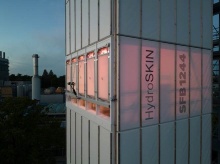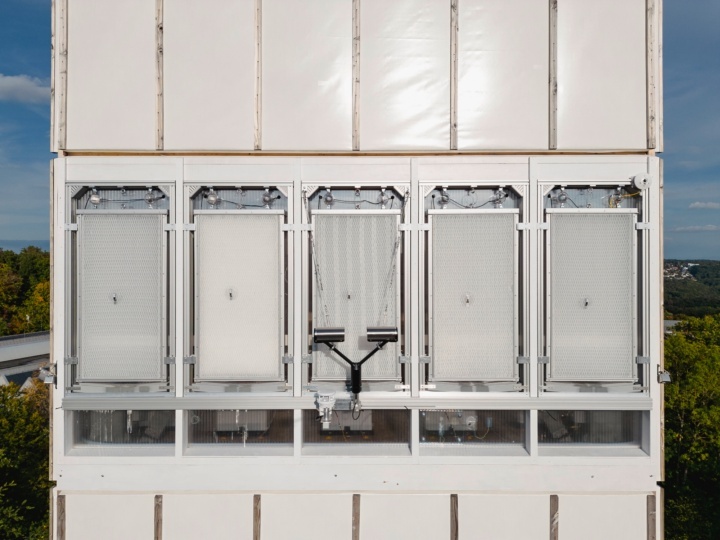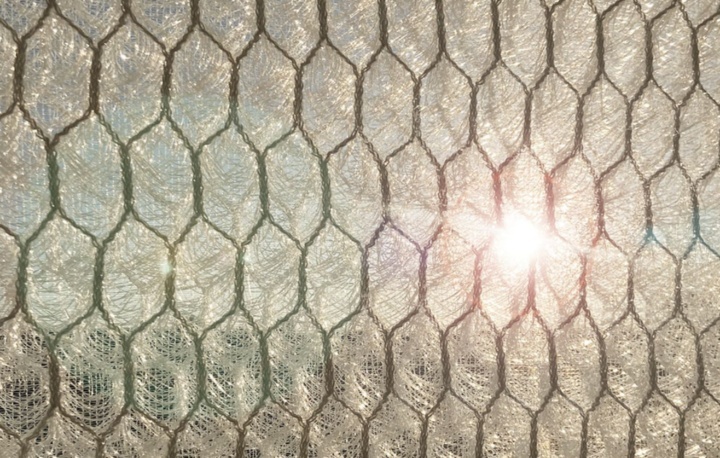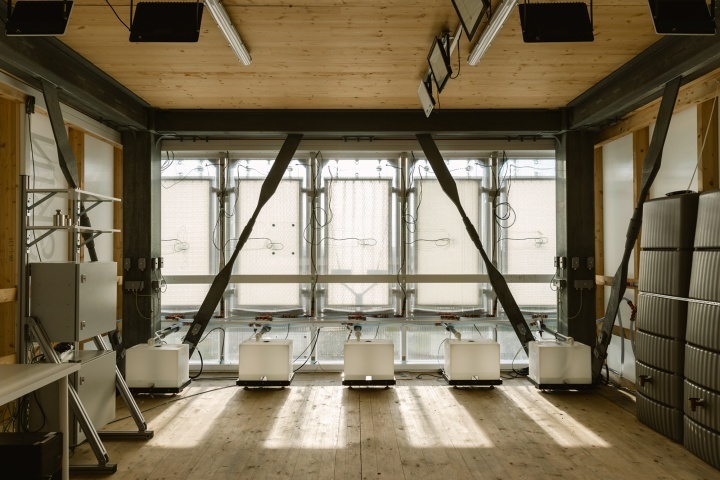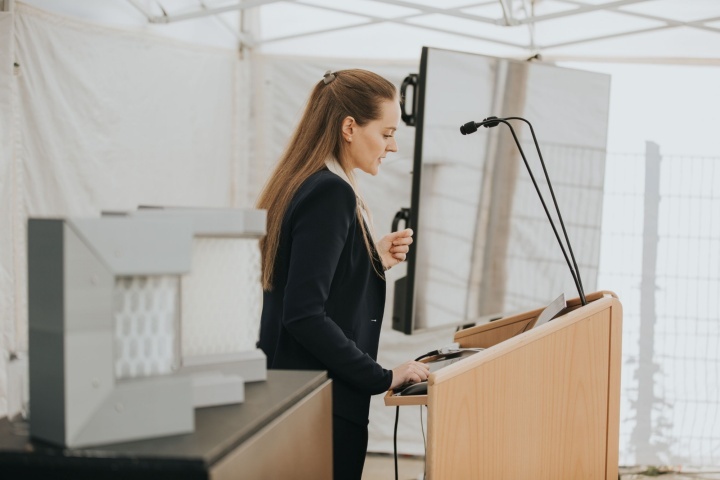The glass façade of a high-rise building can be a major factor in the overheating of our cities. On the other hand, flood events such as torrential monsoon rains produce billions of dollars in damage every year. A solution to both problems was presented at the University of Stuttgart on 4th of October 2022: A hydroactive façade that cools not only exterior walls and the building interior, but also the urban space. The textile façade elements called "HydroSKIN" absorb water when it rains and release it again on hot days for evaporative cooling.
The aerial view of many metropolises, taken with a thermal imaging camera, shows many orange-red spots. The red zones represent built-up areas. Temperatures are significantly higher there than in the "green" parks. The reason for this is that around 60 per cent of the incoming rainwater evaporates via natural surfaces, thus ensuring cooling. Sealed street and building surfaces, on the other hand, allow only 10 per cent of water to evaporate. The remaining 90 percent ends up in the sewage system and leads to another worldwide problem: devastating floods caused by heavy rain. Rising urbanisation, building densification and increasing land sealing exacerbate - in addition to the effects of climate change - heat and flood risks in our cities.
Upgrading the sewage system to tame the ever-increasing masses of water would entail an enormous construction effort. Moreover, this is not a good solution in times of scarce resources, says Prof. Werner Sobek, head of the Institute for Lightweight Design and Construction (ILEK) at the University of Stuttgart until 2020 and former spokesperson of the Collaborative Research Centre CRC 1244 "Adaptive Envelopes and Structures for the Built Environment of Tomorrow": "Hydroactive elements, on the other hand, represent an effective façade solution for neutralising the urban heat island effect with minimal use of resources".
High air circulation promotes evaporation
The core element of HydroSKIN is a so-called spacer fabric, two textile layers that are kept apart by threads and are thus well ventilated. The high air circulation promotes the evaporation of water and enhances the cooling effect of the façade. The knitted fabric is surrounded on the outside by a water-permeable textile cover, which allows almost all raindrops to penetrate and at the same time protects the knitted fabric from contamination. A film on the inside drains the water into the lower profile system. From there, either stored in a reservoir or used directly in the building, it can reduce water consumption. On hot days, water is fed back into the façade element, where it evaporates and thus provides the natural cooling effect. "This façade system represents an artificial retention surface for rainwater retention and evaporation in the building façade, which is not only incredibly beautiful due to its visual and haptic qualities, but at the same time represents a milestone for the adaptation of the built environment to the acute challenges of our time," explains Christina Eisenbarth, Academic Assistant at ILEK and inventor of HydroSKIN.
High-rise facades have particularly high potential
High-rise buildings show particular potential for the application of hydroactive façades - and not only because of their large façade area. On the one hand, with increasing height, the rain hits the façade at an angle as driving rain, so that from about 30 metres building height, more rain can be absorbed by the façade than by a roof surface of the same size. On the other hand, the high wind speeds intensify the evaporative cooling effect and a cool air current is created that moves downwards into the urban space.
The first HydroSKIN elements are currently being tested on the world's first adaptive high-rise building on the Vaihingen campus of the University of Stuttgart, the flagship of the Collaborative Research Centre 1244 and selected project of the International Building Exhibition (IBA). "The results are promising. In laboratory tests we were already able to demonstrate about 10 degrees of temperature reduction due to the effect of evaporation. The first measurements on the high-rise building at the beginning of September indicate an even significantly higher cooling potential," explains Christina Eisenbarth.
"In 2023, another floor of the adaptive high-rise D1244 will be realised with HydroSKIN elements. Gradually, each floor of the building will be equipped with newly developed and innovative façades that will contribute to greater resource efficiency and climate protection," announces ILEK head of department Prof. Lucio Blandini, the planner responsible for D1244 and deputy spokesperson for CRC 1244.
However, the use of the hydroactive façade elements is not limited to the research tower: Since the HydroSKIN elements are very light, they can be retrofitted to any façade in both new and existing buildings.
Festive event on the Vaihingen campus
HydroSKIN was presented on 4th of October 2022 at a ceremony attended by the Vice-Rector for Research and Young Academics at the University of Stuttgart, Prof. Manfred Bischoff, the founder of CRC 1244, Prof. Werner Sobek, the spokesperson for CRC 1244 and head of the Institute for System Dynamics (ISYS), Prof. Oliver Sawodny, the deputy spokesperson for CRC 1244 and head of the Institute for Lightweight Design and Construction (ILEK), Prof. Lucio Blandini, and around 50 other participants from science, business and politics.
| Contact | Christina Eisenbarth, Universität Stuttgart, Institute for Lightweight Structures and Conceptual Design, Tel.: +49 (0)711 685-66138, E-Mail Dr. Walter Haase, Universität Stuttgart, Institute for Lightweight Structures and Conceptual Design, Tel.: +49 (0)711 685-68310, E-Mail |
|---|
Publikation: Potentials of hydroactive lightweight façades for urban climate resilience, Christina Eisenbarth, Walter Haase, Lucio Blandini, Werner Sobek, Wiley Online Library, März 2022, https://onlinelibrary.wiley.com/doi/full/10.1002/cend.202200003


